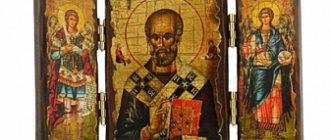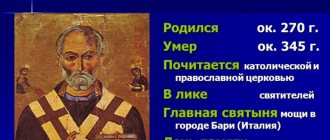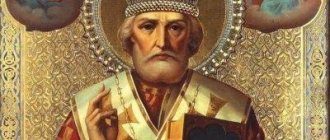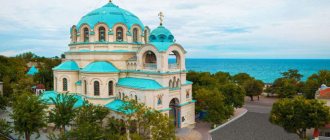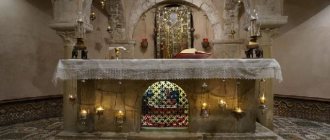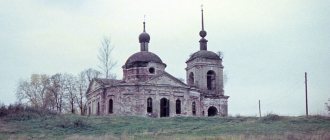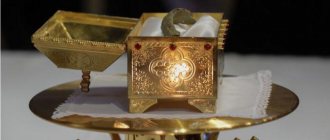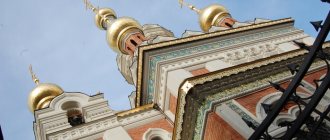Nicholas the Pleasant can rightfully be called one of the most revered saints in Rus'. Therefore, it is not surprising that his image can be found in almost every Orthodox church and, of course, on home iconostasis in the apartments of believers. Where is the icon of St. Nicholas the Wonderworker in Moscow, what should one pray for in front of it? You will find answers to these and other questions in the article below.
So, the image of St. Nicholas the Pleasant can be found in the vast majority of Orthodox churches. However, not all icons depicting the saint are miraculous. We invite you to find out where the miraculous icon of St. Nicholas the Wonderworker is located in Moscow.
How does Saint Nicholas help?
Who needs to buy an icon of St. Nicholas the Wonderworker?
What does the saint help with and who should pray to him especially fervently?
- To all Nicholas, baptized in honor of this saint, this is their heavenly patron.
- Sailors.
- Travelers (especially by sea).
- Entrepreneurs, businessmen.
- Children and their parents.
- To girls praying for a happy and prosperous marriage.
The saint is the patron saint of sailors and travelers due to a miraculous event that occurred during his earthly life. One day, while traveling on a ship, the saint predicted an approaching storm. And so it happened. However, through the prayers of St. Nicholas, the storm subsided. Therefore, even today, when setting out on a journey or already on a trip, it is necessary to pray to the miracle worker. He will protect you - rest assured.
Also, as legend says, Nikolai Ugodnik once saved a merchant from the fall.
The man began to have serious problems in his business, which led to financial difficulties. To rectify the situation, the merchant wanted to give his three daughters to commit fornication. Saint Nicholas could not allow this to happen. Late at night, the righteous man threw bags of gold into the merchant’s windows. Now there was no need for the merchant to send the girls to sin. Therefore, if you are engaged in business, do not forget to pray to the saint.
It is advisable to do this in front of the icon of St. Nicholas the Wonderworker. Thousands of businessmen have become convinced of how the saint helps.
In addition, the saint is the patron saint of children. That is why he became the prototype of Santa Claus, Father Frost and other New Year's characters in different countries. You can pray to Saint Nicholas for the health of children, for their admonition (both children and adults), for the protection of children from criminals and more.
Parents, grandparents, teachers and almost all people who have affection for a particular child can pray for children.
Of course, if you do not belong to the above categories of people, you can also pray to St. Nicholas the Pleasant. A prayer offered with sincere faith will certainly be heard.
LiveInternetLiveInternet
Quote from lora-46
Read in full In your quotation book or community!
SAINT NICHOLAS THE WONDERWORKER / unique ancient icons with the image of the saint
Icon of the late 13th century, kept in the Sinai Monastery of St. Catherine (Egypt)
Icon of the early 15th century, kept in the Novgorod State Historical-Architectural and Art Museum-Reserve (Russia) “St. Nicholas the Wonderworker with scenes from his life” (Byzantine icon of the mid-13th century, kept in the Sinai Monastery of St. Catherine in Egypt)
An icon of the first half of the 16th century, kept in the Arkhangelsk Art Museum. An icon of the second half of the 15th century, kept in the Novgorod State Historical-Architectural and Art Museum-Reserve (Russia)
Icon of the second half of the 17th century, in a private collection
Icon of the second quarter of the 17th century, kept in the Central Museum of Ancient Russian Culture and Art named after Andrei Rublev in Moscow
“The Holy Trinity and Nicholas the Wonderworker” (icon of the mid-16th century, kept in the Pskov State Historical-Architectural and Art Museum-Reserve in Russia)
“Nicholas the Wonderworker with scenes from his life” (14th-century icon, kept in the collections of the State Tretyakov Gallery in Moscow)
SAINT NICHOLAS THE WONDERWORKER
Unique ancient icons with the image of a saint that have survived to this day. All images of icons are signed and their storage locations are indicated.
Nicholas the Wonderworker (Nicholas the Wonderworker, Nicholas of Myra, Saint Nicholas) (in Greek Άγιος Νικόλαος - Saint Nicholas) is a saint in historical churches, in Christianity he is revered as a miracle worker, in the East he is the patron saint of travelers, prisoners and orphans, in the West he is the patron saint of children.
Saint Nicholas is depicted with a miter on his head, a symbol of his bishopric. Saint Nicholas gave rise to the character Santa Claus - the Western Father Frost. Based on his life, which tells about the gift of a dowry by St. Nicholas to the three daughters of a ruined rich man, the first Christmas gifts arose.
According to his life, Saint Nicholas was born in the 3rd century in the Greek colony of Patara in the Roman province of Lycia in Asia Minor at a time when the region was Hellenistic in its culture. Nicholas was very religious from early childhood and devoted his life entirely to Christianity. It is believed that he was born into a family of wealthy Christian parents and received a primary education. From childhood, Nicholas excelled in the study of the Holy Scriptures; During the day he did not leave the temple, but in the evenings he prayed and read books, creating within himself a worthy dwelling of the Holy Spirit. His uncle, Bishop Nicholas of Patarsky, after a while, elevated Nicholas to the rank of priest, making him his assistant and instructing him to speak instructions to the flock. According to another version, thanks to a miraculous sign, by the decision of the Lycian bishops, the layman Nicholas immediately became the bishop of Myra. In the 4th century such an appointment was possible.
The beginning of the sacred ministry of St. Nicholas dates back to the reign of the Roman emperors Diocletian (284-305) and Maximian (286-305) (the emperors ruled jointly). In 303, Diocletian issued an edict legitimizing the systematic, harsh persecution of Christians throughout the empire. After the abdication of both emperors in May 305, changes occurred in the policies of their successors towards Christians. In the western part of the empire, Constantius Chlorus (r. 305-306) put an end to persecution after his accession to the throne. In the eastern part of the empire, Galerius (reigned 305-311) continued persecution until 311, when he announced an edict of toleration while already on his deathbed. The persecutions of 303-311 are considered the longest in the history of the empire. After the death of Galerius, his co-ruler Licinius (reigned 307-324) was generally tolerant of Christians. Christian communities began to gradually develop. The bishopric of St. Nicholas in Myra (the modern city of Demre in the province of Antalya in Turkey) dates back to this period. He fought against paganism, in particular he is credited with the destruction of the pagan temple of Artemis Eleuthera in Myra.
Initially, Saint Nicholas was buried in a church in Myra. In May 1087, Italian merchants stole most of the saint’s relics from the temple in the city of Myra and transported them to the city of Bari (Italy), in their haste and bustle, leaving part of the relics in the sarcophagus in Myra. Nine years later, the Venetians stole the remaining parts of the relics of St. Nicholas and took them to Venice along with the relics of other saints. Nowadays, a little more than half of the relics of St. Nicholas are in the Catholic Basilica of St. Nicholas in Bari, under the altar altar of the crypt. Part of the relics of the saint is located in the Catholic Church of St. Nicholas on the island of Lido in Venice - in a shrine above the throne, above which are installed statues of the martyr Theodore, St. Nicholas the Wonderworker (in the center) and St. Nicholas (uncle Nicholas the Wonderworker). The remaining parts of the relics of St. Nicholas the Wonderworker are scattered throughout the world. In the basilica in Bari, under the throne of the altar of the crypt, a round hole was made into the tomb of St. Nicholas, from which once a year, on May 9, transparent myrrh is removed (myrrh streaming is a phenomenon in Christianity associated with the appearance of oily moisture (the so-called myrrh) on icons and relics saints; the phenomenon represents the appearance on the icon of a light, oily substance emitting a fragrance).
In Orthodoxy, three days are celebrated in honor of St. Nicholas the Wonderworker:
— December 6 (19) — day of death;
— May 9 (22) — the day of arrival of the relics in the city of Bari;
— July 29 (August 11) — the Nativity of St. Nicholas.
Icons depicting a saint
What does the icon of St. Nicholas the Wonderworker mean on the home iconostasis? This speaks of sincere love and reverence for the saint. At home, the icon can be placed in the red corner along with icons of the Lord, the Mother of God and other saints. Often an icon of St. Nicholas the Pleasant is hung above the front door to ask for his protection and patronage to everyone who enters and leaves the house.
However, we are not always at home, but we want to pray to our dear saint quite often. If you spend a lot of time on the road, then it is worth purchasing an icon for your car. Then, while on the road, you can easily pray to God’s saint. By the way, such a gift will be good for any motorist.
In addition, it would be wise to purchase an icon with the image of a saint. Then you will be able to constantly, whenever you want, turn to the saint and, if desired, kiss the icon. There are samples made of precious metals, and there are also those made of non-precious materials (accordingly, they are cheaper).
The image of St. Nicholas of Myra must definitely be in the house or car of those who bear the name of this saint. It can also be a wonderful gift for any Nicholas for a christening or wedding.
So, you can buy:
- Icon on the iconostasis.
- Body image.
- Car icon.
Of course, you can buy all of the above at once. In any case, you can pray to St. Nicholas the Pleasant in front of any of the icons. The main thing is to be sincere in your prayer work.
We hope that the saint will help you and your request will come true!
THE MEANING OF THE ICON OF NICHOLAS THE WONDERWORKER
When Rus' accepted Baptism, the image of the Most Holy One began to be venerated almost on a par with the images of the Mother of God. They asked God's Pleasant for protection from diseases, natural disasters, wars or disasters, and prayed for a good harvest. He was believed to be the patron saint of sailors and travelers.
For the Russian Orthodox people, the saint became a real intercessor, to whom one could turn with any request.
The significance of the holy face grew so much over time that it began to be painted in all churches. At home, the icon of the Venerable One was placed on a par with the Queen of Heaven and the Savior, and at church services they were commemorated no less often than the Divine Couple.
Icons of St. Nicholas the Wonderworker among the Old Believers
For many centuries, this image has enjoyed constant veneration among the Old Believers - representatives of Russian Orthodoxy, who broke away from the official Church in the 17th century due to their rejection of the religious reform of Patriarch Nikon. This conflict, which has been going on for three and a half centuries, has not been resolved to this day.
However, believing that it was not they who departed from true Orthodoxy, but that the official Church itself deviated from it, the Old Believers, or, as they are commonly called, schismatics, act as defenders of the canons established in Byzantine and Old Russian icon painting. At the same time, many distinctive features can be traced in the icons created by their masters.
DESCRIPTION OF HOLY IMAGES
Unlike other faces, the images of St. Nicholas the Wonderworker are very diverse. The iconography of the Pleasant of God in the number of subjects is second only to the images of the Mother of God.
Hagiographic icons
They depict various scenes from the biography of the saint. Often these are miracles that the Reverend performed during his lifetime. For example, the icon “About the Three Stratilates” talks about the salvation of soldiers sentenced to death. The prisoners fervently prayed to the saint, and he achieved pardon for the soldiers.
It is also worth noting some points captured in hagiographic images:
- rescue of seafarers;
- destruction of the temple of the Greek goddess Artemis;
- receiving episcopal rank;
- “baby standing on his legs” during the baptism ceremony, etc.
As a rule, Nicholas the Wonderworker is depicted in clothes that emphasize his episcopal rank. This is a snow-white omophorion with black crosses, a surplice and a chasuble. At first, the Pleasant of God was painted very symbolically, but later his image began to acquire portrait features: a high forehead, gray hair, a thick, neat beard, and a thin, regular nose.
You can see what the saint looked like during his lifetime in the basilica of the Italian city of Bari. It is believed that this miraculous face was painted from a lifetime portrait of the Reverend.
Growth icons
The images of St. Nicholas, in which he is depicted in full growth, belong to the iconographic type of Orans. The most famous image is “Nicholas of Mozhaisk”, on which the saint is presented with the Gospel. Later, another icon was painted on its basis - “Nicholas of Zaraisky”. It appeared in honor of saving the city of the same name from enemies.
Here the Pleasant of God holds a sword with his right hand and a temple with his left, which symbolizes protection and intercession.
No less famous is the wooden sculpture of St. Nicholas the Wonderworker. It repeats the main elements of the Zaraisk image, on which the saint stands with a sword raised up. According to some historians, it was this statue that became the prototype of the above-mentioned icon.
Famous ancient images
Many shoulder-shaped images of the Pleasant of God were painted by order of Tsar Ivan the Terrible, who considered the Reverend his patron. Among them, it is worth noting the unique face of “St. Nicholas the Revolting,” which protects from the devil and drives away evil spirits. Thanks to the unusual angle, it seems that the image is alive, and the penetrating, stern gaze creates a feeling of solitude when you turn to the saint with prayer.
Another famous icon is Ugreshskaya. She helped Dmitry Donskoy during the Battle of Kulikovo.
Also stands about, “Spring” and “Winter”. The first was created in honor of the miraculous rescue of a drowned baby, and an interesting legend is associated with the latter. One day, Emperor Nicholas I made a remark to the icon painter that the bishop should be depicted with all the revered regalia. Since then, on this icon the Pleasant of God has been depicted wearing a miter.
Half-length image of St. Nicholas
In the Orthodox tradition, the iconography of St. Nicholas is subject to strictly established canons, allowing only a few possible spelling options. The most common among them is the half-length image, in which the saint’s right hand is raised in a blessing gesture, and his left hand presses the Gospel to his chest.
On the icon of St. Nicholas the Wonderworker is presented dressed in a bishop's phelonion (chasuble) - a sleeveless outer liturgical robe of purple or red color. Note that during early Christianity it was always white, but in subsequent times this tradition weakened.
In addition, an indispensable attribute of its decoration is the omophorion - a wide and long ribbon with the image of crosses. The saint's left hand, holding the Gospel, is covered with a chasuble, which is a sign of his special respect for the Divine Word. This image is the most common, and can be seen in all Orthodox churches. It is also an indispensable component of most home iconostases.
CELEBRATION OF THE HOLY IMAGE
The church calendar marks three holidays in the name of St. Nicholas the Wonderworker:
- May 9 – discovery of the relics by the Italian basilica of the city of Bari (Nikola Veshny);
- July 29 – birth of God’s Pleasant;
- December 6 – Nikola Winter.
MIRACLES ICONS
Even after death, God’s Pleasant did not abandon those in need and continued to show miracles. The mere fact that his relics were myrrhized immediately after the funeral attracted the attention of millions of believers. History has recorded many cases when the holy face saved lives and helped the disadvantaged. For example, during the Arab-Israeli uprising, the icon, located outside the walls of the monastery, protected it from enemy shells.
They say that during each bombardment the face of the saint appeared over the monastery, protecting the monks with its cover.
Another legend is associated with a poor man who wanted to acquire a miraculous image. A young man came to an antique shop and saw a beautiful icon, which he immediately wanted to buy and donate to the local church. However, the seller asked too high a price, and the young man had little money. A day passed when suddenly the antique dealer himself brought the holy face, without asking for a penny for it. The surprised guy suspected something was wrong and began asking what had happened.
Then the merchant told about a prophetic dream in which Nicholas the Wonderworker appeared to him, telling him to give the image for free.
Rumors about miracles performed by the holy face very quickly spread throughout the globe, and prayers to the Saint became no less popular than to the Mother of God. Thus, one woman was unable to carry her pregnancy to term for a long time. The priest advised her to embroider a miraculous icon, while praying to the saint for help. Exactly nine months after finishing work, the girl gave birth to a healthy baby.
As the patron saint of warriors, Nicholas the Wonderworker helps soldiers at the front, protecting them from death.
A striking example is the story of an eyewitness who miraculously survived. When their platoon was moved closer to the line of fire, the soldiers dug a trench and went to bed. Suddenly, one of them was awakened by a gray-haired old man who had appeared out of nowhere and ordered him to run away immediately. Not yet fully awakened from sleep, the young man rushed out of the trench, and when he finally stopped, a mine flew in, killing everyone who remained.
Protector of the weak and captives
From the pages of the Life of St. Nicholas it is known that even in his youth the Lord gave him the grace to resurrect the dead - just remember the episode with the sailor who fell from the mast, fell to his death and was brought back to life by the power of his prayer. With this, the saint gave grounds to ask his intercession before the throne of God for the sending of health to the suffering and salvation from premature death for all who believe in the mercy of the Almighty.
Carefully studying the biography of Nicholas the Wonderworker, it is not difficult to find reasons for the prayers offered for those who find themselves behind prison bars, since the saint himself was honored to endure this hardship. For those who got there innocently, he begs God for speedy release, and for criminals - sincere repentance and relief from suffering. There are many known cases when Saint Nicholas the Wonderworker himself appeared to captives and saved them from inevitable death. There were especially many such episodes during the Bolshevik persecution of the Church.
Why do you dream about the icon of St. Nicholas the Wonderworker?
If in his dream a person saw that the divine image came to life and told him some information, then such a dream can be considered prophetic.
As a rule, it is interpreted as a favorable sign, that is, soon, unexpectedly, incredible miracles will begin to happen in the dreamer’s life.
In which temples is the miraculous face located?
Since there are a huge number of lists of this icon, we will tell you about the location of some of them:
- In the Cathedral of Christ the Savior in Moscow there is a Holy Image, which was painted in Bari, where the Basilica of St. Nicholas was built;
- The revered image of St. Nicholas in the Life on Presnya in the Church of the Nativity of John the Baptist, however, a face with a similar plot can be seen on Peski in the Church of the Transfiguration;
- In Elekhov there is another miraculous image of the Saint. The cathedral contains particles of relics and a list depicting St. Nikola, VMC. Barbara and St. Basil the Great;
- You can see the Kolpino face of the Wonderworker in the Church of the Holy Trinity “Kulich and Easter” in St. Petersburg.
Cast Old Believer icons
Continuing the conversation about the history of the icon of St. Nicholas the Wonderworker, one cannot help but recall its special type, which became widespread during the period of the 18th – 19th centuries among numerous representatives of Old Believer communities. These are the so-called mortise or, simply put, cast copper icons, which have a number of characteristic features. A photo of one of them can be seen in the article.
Having first appeared in the Urals and Western Siberia, they were repeatedly banned by church and secular authorities as not complying with established canons. Despite the fact that during the period indicated above, copper casting, which underlies the technological process of their production, developed among the entire Orthodox population of Russia, the production of this kind of icons, which did not receive the blessing of the highest clergy, was strictly prosecuted by law. The workshops in which they were cast were subject to closure, and their owners were subject to significant fines.
Life of Nicholas the Wonderworker
The life story of St. Nicholas is full of miracles. From childhood he was sincerely religious, prayed fervently and devoted all his time to the study of the Holy Scriptures. When his parents died, Nikolai distributed his entire considerable inheritance to those in need, but he always did it in secret.
He began serving in the church early, spreading the True Faith even in those days when it was persecuted by the Roman emperors, and fought against paganism and the Arian heresy. He became the bishop of the city of Myra in Lycia (in modern Turkey), which is why the icon “Nicholas the Wonderworker of Myra” is sometimes found.
As the legend says, for his piety and selfless life, the Lord, during his lifetime, awarded Nicholas the gift of performing miracles, many of which are depicted on the icon of St. Nicholas the Wonderworker with stamps.
Thus, through prayer he resurrected a sailor who had fallen to his death by falling off the mast; another time he pacified a storm that threatened the ship with destruction.
But no less important are the good deeds performed by St. Nicholas, which many revered as a miracle. There is a widely known story about how he helped three poor sisters with their dowry, quietly throwing bags of gold to them one by one.
When the two eldest were successfully married, and the third sister remained in line, their father decided to find out who had become the benefactor of the family, and, hiding, he saw St. Nicholas. He threw himself at his feet with gratitude, but Nikolai strictly forbade him to talk about his good deed.
During his life, Saint Nicholas saved many slandered and innocently convicted people, acted as a pacifier to warring parties and a champion of justice for everyone, regardless of rank and wealth.
Icon – defender of cities
There is another very characteristic type of icon of St. Nicholas the Wonderworker. A photo of one of them is given in the article. On it, he stands at full height, clutches a sword in his right hand, and holds a reduced image of a fortress in his left. On icons of this kind, the Bishop of Myra is represented as the defender of Orthodox cities and is called “Nicholas of Mozhaisk”. The tradition of painting this image is associated with a legend according to which in ancient times hordes of Tatars approached Mozhaisk, and its inhabitants, not expecting any other salvation, offered prayers to the saint for help.
Their hearts were so filled with faith, and their words were full of ardent feeling, that suddenly Nicholas the Wonderworker himself appeared in the sky above the cathedral with a sword in his hands. His appearance was so terrifying that he put his enemies to flight and filled the townspeople with joy. At the same time, he was recognized as the heavenly patron of Mozhaisk, and his image, associated with this city, began to be widely revered throughout Ancient Rus'.
Patron of prisoners and unjustly convicted
Another incident from the life of Nicholas the Wonderworker is reflected in the famous painting by Ivan Repin: the saint suddenly appeared on the square during the execution of three condemned prisoners of the city prison and literally grabbed the hand of the executioner, who was already raising his sword.
No one dared to argue with the universally respected bishop of the church, the execution was postponed, and soon evidence of the innocence of the convicts was found. The Lord revealed the true circumstances of the case to Saint Nicholas in advance, so that the saint would help the prisoners and prevent the unjust execution.
From then until now, Nicholas the Wonderworker has been helping all those unjustly convicted.
However, those prisoners who know that they received their punishment deservedly also often turn to him with a request for intercession before God. And Nicholas the Wonderworker helps everyone, because the highest virtue of a Christian, for which this saint has always been famous, is the ability to forgive even those who have stumbled on the path of life.
Icon of St. Nicholas the Wonderworker helps a non-believer
And this story happened many years after the earthly death of St. Nicholas, in the 1920s in the Chinese city of Harbin. In early spring, a local fisherman went to the river. The weather was already warm and suddenly the ice broke, and the unfortunate fisherman found himself in cold spring water.
He felt himself being sucked into the depths and realized that he was dying. At the last moment, the fisherman remembered the mysterious image-icon that Russian emigrants hung at the city station. “The old man of the station, help, save me!” he begged and immediately lost consciousness. The fisherman woke up already on the shore far from the water.
This incident was recalled in his book by the famous pop singer of the first half of the 20th century, Alexander Vertinsky. Vertinsky writes that later that Chinese converted to Orthodoxy, and his example was followed by some of his fellow countrymen.
Texts in Russian
For those believers who want to turn their thoughts to the image of the saint, below are various prayers and church hymns, the reading of which helps in difficult life situations. These include:
- troparion;
- kontakion;
- grandeur;
- strong prayers that relieve diseases;
- canon;
- Akathist
Troparion
The rule of faith and the image of meekness, self-control, the teacher, show you to your flock as things are true; For this reason, you have gained high humility, rich in poverty, Father Hierarch Nicholas, pray to Christ God to save our souls.
Kontakion
In Mireh, the holy one, you appeared as a priest: For Christ, O Reverend, having fulfilled the Gospel, you laid down your soul for your people, and you saved the innocent from death; For this reason you have been sanctified, as the great hidden place of God’s grace.
Greatness
We magnify you, Father Nicholas, and honor your holy memory: you pray for us to Christ our God.
Powerful Prayers
Powerful prayers that help people who truly believe in God include:
- Prayer for health and healing.
- Prayer for help in business.
- Prayer for the fulfillment of secret desires.
About healing from illnesses
“O all-holy Nicholas, exceedingly saintly saint of the Lord, our warm intercessor, and everywhere in sorrow a quick helper, help me, a sinner and saddened one, in this life, beg the Lord God to grant me forgiveness of all my sins, which I have sinned greatly from my youth, in everything my life, deed, word, thought and all my feelings; and at the end of my soul, help me the accursed, beg the Lord God of all creation, the Creator, to deliver me from airy ordeals and eternal torment, so that I always glorify the Father, and the Son, and the Holy Spirit, and your merciful intercession, now and ever, and forever and ever. Amen"
About help in business and trade
“Oh, all-good Father Nicholas, shepherd and teacher of all who flow by faith to your intercession, and who call upon you with warm prayer, quickly strive and deliver the flock of Christ from the wolves that destroy it, that is, from the invasion of the evil Latins who are rising against us.
Protect and preserve our country, and every country existing in Orthodoxy, with your holy prayers from worldly rebellion, the sword, the invasion of foreigners, from internecine and bloody warfare. And just as you had mercy on three men imprisoned, and you delivered them from the king’s wrath and the beating of the sword, so have mercy and delivered the Orthodox people of Great, Little and White Rus' from the destructive heresy of the Latin.
For through your intercession and help, and through His mercy and grace, may Christ God look with His merciful eye on people who exist in ignorance, even though they have not known their right hand, especially young people, by whom the Latin seductions are spoken to turn away from the Orthodox faith, may he enlighten the minds of His people, may they not be tempted and fall away from the faith of their fathers, conscience,
lulled by vain wisdom and ignorance, may he awaken and turn his will to the preservation of the holy Orthodox faith, may he remember the faith and humility of our fathers, who laid down their lives for the Orthodox faith, who accepted the warm prayers of His holy saints, who shone in our land, keeping us from delusion and Latin heresies, so that, having preserved us in holy Orthodoxy, He will grant us standing at His right hand at the terrible Judgment with all the saints. Amen"
About work
“Saint Nicholas the Wonderworker, protector and benefactor. Cleanse my soul from the pestering envy and malice of bad people. If the work does not go well due to damned intent, do not punish your enemies, but help them cope with the turmoil in their souls. If there is sinful soot on me, I sincerely repent and ask for miraculous help in righteous work. Grant me a job according to my conscience, and a salary according to my work. Let it be so. Amen".
“I turn to you, Saint Nicholas, and ask for miraculous help. May your search for a new job be successful, and may all difficulties suddenly dissolve. Let the boss not be angry, but let the matter go smoothly. Let the salary be paid, and you like the work. If an envious person shows up, let his anger fall apart. Forgive me for all my sins and do not leave me as before in difficult days. Let it be so. Amen".
At a profit
“O our good shepherd and God-wise mentor, Saint Nicholas of Christ! Hear us sinners (names), praying to you and calling on your speedy intercession for help: see us weak, caught from everywhere, deprived of all good and darkened in mind from cowardice. Strive, servant of God, do not leave us in the captivity of sin, so that we may not joyfully be our enemy and die in our evil deeds.
Pray for us unworthy of our Creator and Master, to whom you stand with the disembodied faces: make our God merciful to us in this life and in the future, so that He will not reward us according to our deeds and the impurity of our hearts, but according to His goodness He will reward us.
We trust in your intercession, we boast of your intercession, we call upon your intercession for help and we ask for help in your most holy image: deliver us, saint of Christ, from the evils that come upon us, so that for the sake of your holy prayers the attack will not overwhelm us and we will not wallow in the abyss more sinful and in the mud of our passions.
Pray to Saint Nicholas of Christ, Christ our God, that he may grant us a peaceful life and remission of sins, salvation and great mercy for our souls, now and ever and unto ages of ages. Amen".
For good luck
“Oh, all-validated, great wonderworker, Saint of Christ, Father Nicholas!
We pray to you, awaken the hope of all Christians, protector of the faithful, feeder of the hungry, joy of the weeping, doctor of the sick, steward of those floating on the sea, feeder of the poor and orphans, and quick helper and patron of all, may we live a peaceful life here and may we be worthy to see the glory of God’s elect in heaven , and with them unceasingly sing the praises of the one worshiped God in the Trinity forever and ever. Amen."
On request
“Wonderworker Nicholas, help me with my mortal desires. Do not be angry at the impudent request, but do not abandon me in vain matters. Whatever I wish for good, fulfill with your mercy. If I want something bad, turn away adversity. May all righteous wishes come true, and may my life be filled with happiness. Thy will be done, amen."
There is an opinion that the icon of St. Nicholas the Wonderworker helps even those who do not believe in the Lord. However, it is worth remembering that prayer gains true power only when a person leads a righteous lifestyle, follows God’s commandments, takes communion and regularly attends church.
It is not words that grant salvation, but true faith in the omnipotence of the Higher Powers.
Defender of victims of arbitrariness
As is known, during the days of his earthly life the saint, interceding for victims of oppression, fearlessly entered into conflicts with the powers that be, endangering himself, and pacified the anger of the rulers. The Lord preserved this grace for him even after his blessed death. Therefore, from time immemorial it is believed that among the numerous host of saints who find themselves at the Throne of God, there is no better defender than him, and prayers for help offered before the icon of St. Nicholas the Wonderworker, are extraordinarily blessed. It is not for nothing that in one of them (the text is given in the article) he is called a “warm intercessor” and a “quick helper” in all sorrows.
